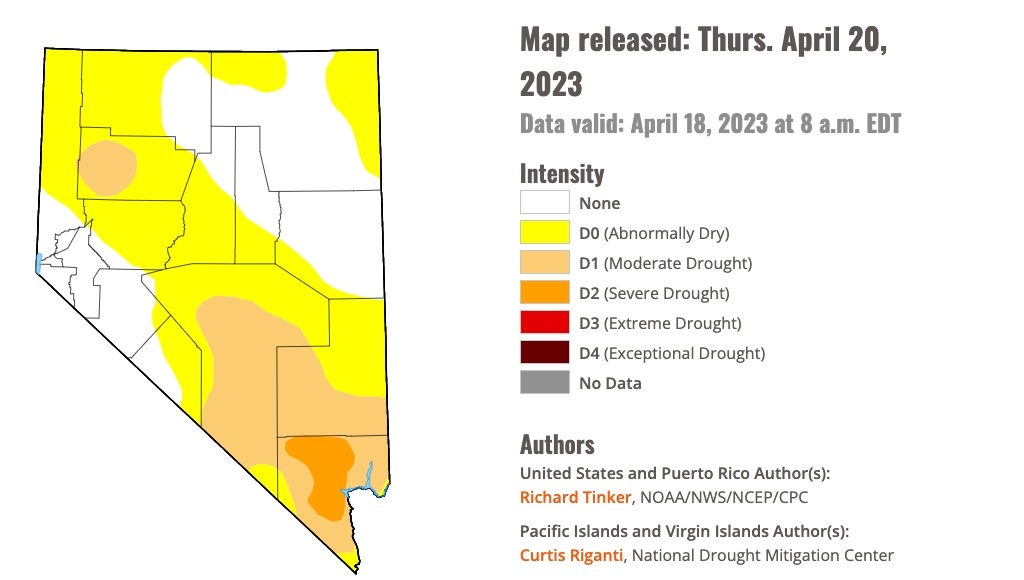Nevada Gov. Joe Lombardo at the Capitol Building on Tuesday with Nevada State Forester and Firewarden Kacey KC, left, and James Settelmeyer, director of the Nevada Department of Conservation and Natural Resources, right.
Photo by Scott Neuffer.
A wet winter and large snowpack won’t prevent a wildfire season this year, but local, state and federal leaders hope agencies and the public are ready for the warmer months and the threat of fire when it comes.
“The easiest fire to put out is one that never starts,” said Dave Cochran, Reno fire chief and president of the Nevada Fire Chiefs Association. “It’s the cheapest; it’s the most efficient and the least destructive.”
Encouraging Nevadans to be proactive — and pointing to www.livingwithfire.com as a free resource — Cochran was one of several speakers at the Capitol Building on Tuesday briefing Republican Gov. Joe Lombardo on the upcoming fire season. Their forecast was for mixed conditions: less fire activity in higher elevations but more potential danger in lower elevations.
“This year, we are less worried about the upper elevations, at least early in the season, because there is a large snowpack still sitting up there,” said Nevada State Forester and Firewarden Kacey KC.
The bigger concern was lower elevations “in the rangelands where the grasses tend to grow,” she said.
KC noted last year, the Silver State had 504 fires, 303 of those caused by humans. Approximately 58,405 acres burned, which is below average. Overall, wildfires are consuming more. KC shared data showing 5.3 million acres burned in Nevada from 1983 to 2002. From 2003 to 2022, roughly 8.8 million acres burned. In those same timeframes, the average amount of acres burned per year jumped from 267,371 to 442,458.
KC also pointed out a trend that doesn’t bode well for the coming years, which is that high fire activity follows wet years. For example, in comparing acres burned with flows on the Humboldt River, 1999 holds the record in the state for 1.7 million acres burned. That season followed a wet 1998.
“The years when we have our highest water inputs from snow and rain, the three years that follow that tend to be our highest fire seasons as far as acres burned,” she said.
Although the Sierra is in better condition from the snowpack — exceeding 300 percent of normal in some areas — large areas of Nevada remain in abnormally dry or moderate drought conditions.
 The U.S Drought Monitor, updated April 18, showing sections of Nevada still in dry conditions.
The U.S Drought Monitor, updated April 18, showing sections of Nevada still in dry conditions. Brock Uhlig of the U.S. Bureau of Land Management said much of the wildfire season will depend on weather.
“It’s going to be driven really by temperature and humidity,” he said. “When we get into longer spells of higher temperatures and lower humidity, our fuels will start to dry out.”
Uhlig said soils remain wet across the state, creating more grass.
“If you look at the hills right now, they’re just starting to get green,” he said. “When those fine fuels start to cure out, that’s when we’ll start getting into fire season for the majority of the state.”
Uhlig compared a presently mild April with what’s to come.
“It has been cooler than normal, and around normal for precipitation,” he said. “Going into summer, we’re looking to be above normal temperatures for the next few months. And then one month in June when we may have above normal precipitation. That’s not always a good sign for fire season as that can be the lightning coming in as well.”
Bill Dunkelberger, forest supervisor for the Humboldt-Toiyabe National Forest, stressed the importance of “resilient landscapes.” Last year, 230,262 acres were treated in Nevada through thinning, prescribed burns, targeted grazing and the creation of defensible space, among other measures. More acres were treated to reduce fuels than burned last year, according to Dunkelberger.
Fire officials also discussed the importance of interagency cooperation involving state, federal and local agencies.
“I remember going back 10, 20 years ago, we didn’t have this,” said James Settelmeyer, former state lawmaker and now-director of the Nevada Department of Conservation and Natural Resources.
Settelmeyer said cooperation starts with people.
“We’re all sitting here in the middle of all this water thinking OK, nothing is going to burn … probably not for a couple days … but when the weather gets to 85 here by Thursday, that could change.”
Lombardo thanked those in attendance for being proactive. He then read a proclamation declaring the month of May to be Wildfire Awareness Month in Nevada. He said the theme this year is “protect our home, prepare for wildfire.”